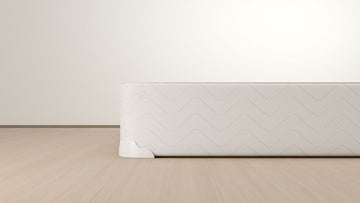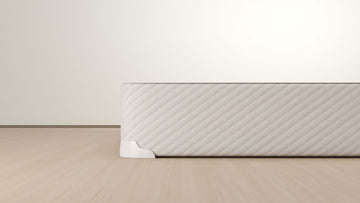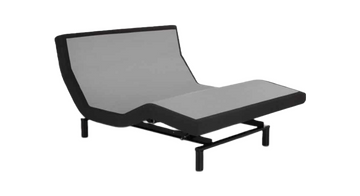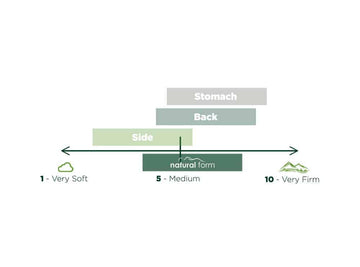One of the most important criteria to consider when mattress shopping is firmness. Mattress firmness often comes off as more complex than it really is, due to the fact that mattress firmness is subjective and, frankly, personal.
We simplified the mattress firmness scale to make it clear and straightforward, so that you can easily determine which mattress firmness is best for you. We’re going to breakdown the difference between firmness vs. support, different firmness levels, and show you a numerical firmness scale to use as a tool in your mattress shopping experience.
The problem with firmness extremes
Although some extreme firmness options can be tempting, sometimes it is best for your body to opt out. That’s not to say firmness adjustability is bad–quite the contrary, actually. You want a mattress where you can ideally adjust your firmness to provide optimal comfort and support.
Firmness options that allow your bed to be hard as a rock–or so soft you sink into a hole– may seem comfortable to some, but it is not necessarily good for you. It is recommended you sleep in a small range of firmness from about 4-8. This will allow you to adjust towards firmer or softer for your comfort, but without straying to extremes that will compromise the amount of support you receive.
What is universal comfort?
You may have heard the phrase “universal comfort” or “universal firmness” during your mattress search. These brands claim to offer a one-size-fits-all firmness. When there are so many firmness options to choose from, that description is often very appealing. But the key to firmness is to remember that it is extremely subjective, and with different varying body types and sleep styles, one mattress firmness will not suit everyone.
With brands categorizing their mattresses firmness with confusing terms such as “relaxed firm,” or the “perfect firmness.” These terms beg the question, what is it’s actual firmness? The three firmness descriptions you want to go by are simple: soft, medium, and firm.
Choosing a soft, medium or firm mattress
Firmness is essentially the initial feel when you lay on a mattress. Not to be confused with support, firmness is the amount of pushback you receive from the upper comfort layers of a mattress.
If you experience stiff push back, the mattress can be categorized as very firm or firm. If the response is cloud-like with immediate cushion and contour, the mattress is typically described as soft. Medium firmness is classified as a balanced level of pushback and cushion. Thankfully, we can break up this pushback sensation into numerical values, called a mattress firmness scale.
The mattress firmness scale ranges from 1 to 10, with 1 being the most soft and 10 being the most firm.
Mattresses that would be categorized as a 1 or 2 are extremely rare, and you are unlikely to come across a mattress this soft as it most likely yields little support.
Soft 3-4
Medium 5-6
Firm 7-8
Very Firm 7-8
Is firmness the same as support?
How to choose mattress firmness
Use a point of reference
Use your current mattress as a point of reference. If you know where your current model typically falls on the mattress firmness scale, you can move towards a firmer or softer mattress from there. Here’s how to tell if a mattress is too firm or too soft:
Have there been instances where you slept at a friend’s or in a hotel, and noted a mattress you hated, or one that you loved? If there were times where a bed that was too plush or too firm resulted in a poor night’s sleep, keep that in mind.
Remember your personal experiences are the most valid. They are the best jumping off point in searching in the large pool of mattress firmness scales.
Have there been instances where you slept at a friend’s or in a hotel, and noted a mattress you hated, or one that you loved? If there were times where a bed that was too plush or too firm resulted in a poor night’s sleep, keep that in mind.
Remember your personal experiences are the most valid. They are the best jumping off point in searching in the large pool of mattress firmness scales.
Sleep position
Depending on your sleep position, you will have pressure points on different parts of your body. For example, if you sleep on your side, you want a lot of support for your shoulders. But if you are a back sleeper, you want a lot of support in your lumbar region. Different firmnesses will support these specific regions of your body differently.
Many side sleepers prefer a soft mattress, because the plush contours and sinkage support both the hips and shoulders. Side sleepers have an arm that gets tucked underneath them while sleeping, and a mattress that is really firm will cause it to feel crushed, numb, and tingly.
Back sleepers have a wide range of firmness preference because pressure points in this position are more evenly distributed. So take your pick on firmness, but be sure that you have a good support system nonetheless. For those that experience back pain however, you will most likely want a mattress on the medium/firm side.
Stomach sleepers often prefer a medium to firmer mattress, because they need additional support in the middle region. Too plush of a mattress will cause the hips to sink lower than the rest of your body, which can cause back pain. If you like a plush feel and you’re a stomach sleeper, opt for high resiliency foam, so that you get the push back coupled with a soft contouring feel.












